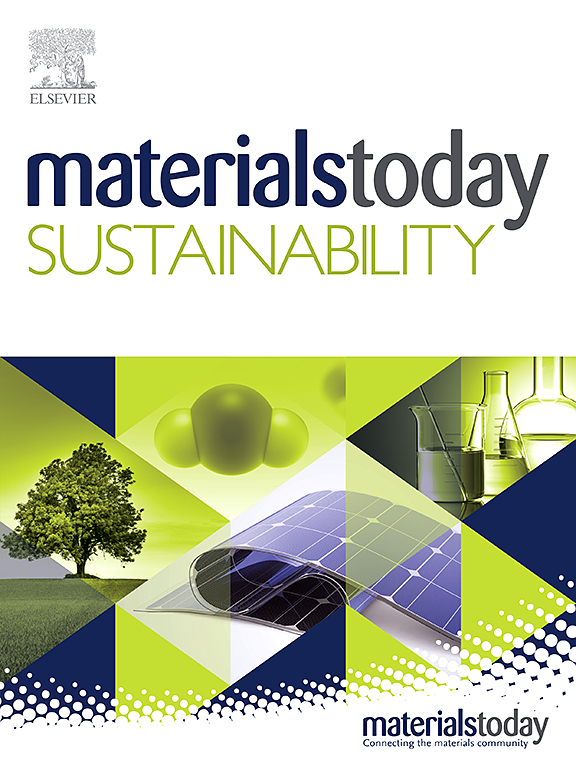一步环境友好型合成半导体ZnS/OE-PE:太阳能光辅助评价抗生素降解,无pt制氢和抗菌评价
IF 7.1
3区 材料科学
Q1 GREEN & SUSTAINABLE SCIENCE & TECHNOLOGY
引用次数: 0
摘要
四环素等药物污染物对水资源的污染是一个重大的环境和健康问题。利用半导体材料的光催化降解已成为解决这一挑战的一种有前途的方法。本研究的主要目的是利用绿色原料(牛骨草甲醇植物提取物)合成硫化锌纳米颗粒,并研究其在四环素降解、产氢和抗菌方面的效率。纳米颗粒的系统光谱表征使用了几种最先进的分析测量方法,如紫外可见光谱、FTIR光谱、x射线衍射、扫描电子显微镜、透射电子显微镜、动态光散射、Zeta电位和x射线光电子能谱。在光催化降解四环素的实验中,制备的ZnS纳米颗粒表现出优异的活性,在30 min内达到了97%的降解效率。此外,研究了所制备的光催化剂通过光催化水裂解产氢的潜力。制备的纳米颗粒的量为18.59 mmol g−1h−1,表明所合成的光催化剂具有连续6次循环产氢的潜力。最后,研究了制备的纳米颗粒对H1(克雷伯氏菌)、38(芽孢杆菌)和大肠杆菌的抗菌潜力。对H1(克雷伯氏菌)和38(芽孢杆菌)的抑制值分别为6 nm和8 nm。本文章由计算机程序翻译,如有差异,请以英文原文为准。
One-step environment-friendly synthesized semiconductor ZnS/OE-PE: Solar light assisted evaluation of antibiotic degradation, Pt-free hydrogen production, and antibacterial assessment
The contamination of water resources by pharmaceutical pollutants, such as tetracycline, positions a significant environmental and health concern. Photocatalytic degradation using semiconductor materials has emerged as a promising method to address this challenge. The primary objective of this study is to synthesize zinc-sulfide nanoparticles from a green source (methanolic plant extract of oxystelma esculentum) and investigate their efficiency in tetracycline degradation, hydrogen production, and antibacterial efficacy. The systematic spectroscopic characterizations of the nanoparticles were carried out using several state-of-the-art analytical measurements, such as UV–Vis spectroscopy, FTIR spectroscopy, X-ray diffraction, Scanning electron microscopy, Transmission electron microscopy, Dynamic light scattering, Zeta potential, and X-ray photoelectron spectroscopy. In the photocatalytic degradation experiments of tetracycline, the prepared ZnS nanoparticles exhibited exceptional activity, achieving a remarkable degradation efficiency of 97 % within only 30 min. Moreover, the prepared photocatalyst was examined for its potential to produce hydrogen by photocatalytic water splitting. Prepared nanoparticles exhibited an amount of 18.59 mmol g−1h−1, indicating the befitting potential of the synthesized photocatalyst for H2 production for consecutive 6 cycles. Finally, the prepared nanoparticles were examined for their antibacterial potential against H1(klebsiella), 38(Bacillus), and E.coli. The observed inhibition values were 6 and 8 nm, respectively, against H1(klebsiella) and 38(Bacillus).
求助全文
通过发布文献求助,成功后即可免费获取论文全文。
去求助
来源期刊

Materials Today Sustainability
Multiple-
CiteScore
5.80
自引率
6.40%
发文量
174
审稿时长
32 days
期刊介绍:
Materials Today Sustainability is a multi-disciplinary journal covering all aspects of sustainability through materials science.
With a rapidly increasing population with growing demands, materials science has emerged as a critical discipline toward protecting of the environment and ensuring the long term survival of future generations.
 求助内容:
求助内容: 应助结果提醒方式:
应助结果提醒方式:


